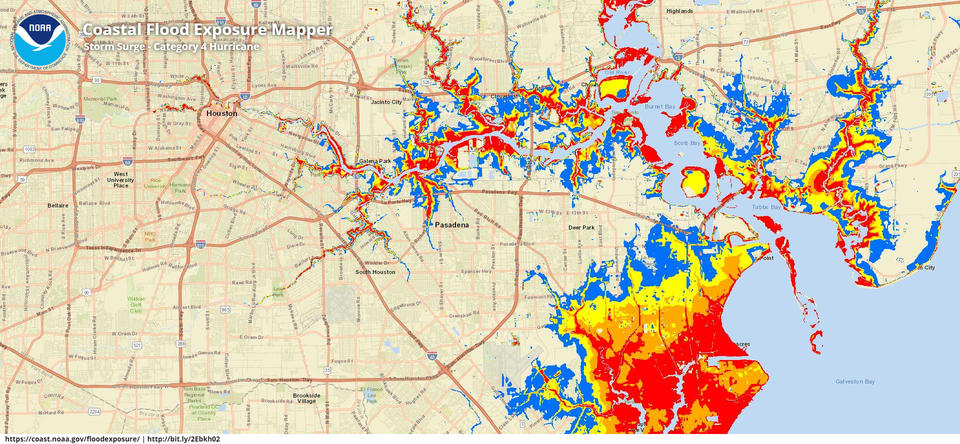
NOAA's Coastal Flood Exposure Mapper is a free online tool that provides information to assess risks related to coastal flooding and hazards. This map shows areas in Houston, TX that are vulnerable to storm surges during a category 4 hurricane according to a flooding model.
The National Institute of Standards and Technology (NIST) has issued the U.S. Department of Commerce’s (DOC) 2018 Annual Report on Technology Transfer. The report describes the outcomes of transfer efforts from DOC’s three research laboratories — NIST, the National Oceanic and Atmospheric Administration (NOAA) and the National Telecommunications and Information Administration’s (NTIA) Institute for Telecommunication Sciences (ITS), and it shows an increase in several transfer activities over the past five years.
“Technology transfer is an essential part of the mission of each federal science and technology agency,” said Under Secretary of Commerce for Standards and Technology and NIST Director Walter G. Copan. “This report shows important progress is being made to deliver impacts from our national investment in research and development for the benefit of Americans and the U.S. economy.”
In fiscal year (FY) 2018, DOC researchers participated in 534 traditional collaborative research and development agreements (CRADAs), which is 120 more than the previous fiscal year. CRADAs in FY 2018 included 53 joint agreements between NIST and ITS focused on public safety broadband demonstrations. DOC labs also disclosed 77 new inventions, filed 56 patent applications, and received 28 patents. Of the department’s 67 active patent licenses, 37 were income-bearing — the most since FY 2003 — and generated $147,414 in royalty income. Altogether, DOC researchers published 3,220 scientific and technical publications in peer-reviewed journals.
Technology transfer from these labs goes beyond traditional measures. It encompasses participation in standards committees; the production of software, data and reference materials; the availability of user facilities; and the training of postdoctoral and guest researchers.
Examples of NIST contributions in FY 2018 include updated standard reference materials (SRMs) for ballistics and DNA, both of which enable instrument calibrations in forensic labs. NIST also made an SRM available for purchase that could be used to evaluate cancer measurements. By using its Synchrotron Ultraviolet Radiation Facility, NIST worked with CRADA partners to characterize extreme ultraviolet light damage, which is a major hurdle in the advancement of microelectronics, and supported testing and calibration of satellite sensors for NOAA and NASA.
To give a boost to farmed seafood production in the U.S., NOAA scientists and collaborators sequenced the genome of a highly valued fish in the raw seafood industry, revealing insights that could improve aquaculture practices. NOAA has also made available a mapping tool known as EcoCast that can inform fishermen of the best fishing spots in real time. Another of NOAA’s technology transfer efforts permitted novel analyses such as a study that highlighted the need to conserve certain habitats for birds migrating across the U.S.
In FY 2018, ITS offered guidance to the telecommunications standards organization 3GPP in the development of 5G standards and aided the U.S. Department of Transportation’s efforts to assess vehicular safety messaging technology based on earlier ITS work in vehicle-to-vehicle communications. Using the ITS Table Mountain Field Site, near Boulder, Colorado, university researchers tested the sensing and communication capabilities of small unmanned aircraft used for applications such as the study of tornado formation.
The DOC annual report underscores the central role of technology transfer in the department’s mission to foster job creation, economic growth, sustainable development and improved standards of living for all Americans.
Past technology transfer reports and economic impact studies can be found on the NIST website.
For more information on licensing technologies and how to work with DOC, contact the NIST Technology Partnerships Office, NOAA Technology Partnerships Office or the ITS.
Learn about what federal agencies can do to increase the impacts of federally funded R&D in the NIST green paper, Return on Investment Initiative to Advance the President’s Management Agenda.
As a nonregulatory agency of DOC, NIST promotes U.S. innovation and industrial competitiveness by advancing measurement science, standards and technology in ways that enhance economic security and improve our quality of life. More information about NIST can be found at www.nist.gov.
###

